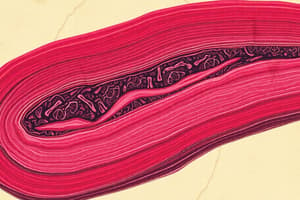Podcast
Questions and Answers
What is smooth muscle tissue primarily found in?
What is smooth muscle tissue primarily found in?
- Skeletal muscles
- Blood vessels
- Walls of internal organs (correct)
- Heart
What are the characteristics of smooth muscle tissue?
What are the characteristics of smooth muscle tissue?
Single nucleus per cell, no branches, no cross striations, slow rhythmic prolonged contractions, involuntary movement.
Describe the structure of smooth muscle cells.
Describe the structure of smooth muscle cells.
Fusiform cells (spindle shaped with tapered ends)
Where are the nuclei of smooth muscle cells located?
Where are the nuclei of smooth muscle cells located?
What does the sarcoplasm of smooth muscle cells contain?
What does the sarcoplasm of smooth muscle cells contain?
Describe the arrangement of myofilaments in smooth muscle cells.
Describe the arrangement of myofilaments in smooth muscle cells.
What are dense bodies in smooth muscle cells analogous to?
What are dense bodies in smooth muscle cells analogous to?
What is the function of cavolae in smooth muscle cells?
What is the function of cavolae in smooth muscle cells?
What is the role of gap junctions in smooth muscle cells?
What is the role of gap junctions in smooth muscle cells?
What surrounds smooth muscle cells?
What surrounds smooth muscle cells?
Thin filaments of smooth muscle cells contain troponin complex.
Thin filaments of smooth muscle cells contain troponin complex.
What are the three major proteins of thin filaments?
What are the three major proteins of thin filaments?
What is G-actin?
What is G-actin?
What is the function of tropomyosin in smooth muscle?
What is the function of tropomyosin in smooth muscle?
What does caldesmon do in smooth muscle?
What does caldesmon do in smooth muscle?
Describe the structure of thick filaments in smooth muscle cells.
Describe the structure of thick filaments in smooth muscle cells.
How is smooth muscle stimulated neurally?
How is smooth muscle stimulated neurally?
What kind of hormones can stimulate smooth muscle contraction?
What kind of hormones can stimulate smooth muscle contraction?
What causes mechanical stimulation of smooth muscle fibers?
What causes mechanical stimulation of smooth muscle fibers?
What are the steps in smooth muscle contraction?
What are the steps in smooth muscle contraction?
What happens during smooth muscle relaxation?
What happens during smooth muscle relaxation?
What is the latch state of smooth muscle cells?
What is the latch state of smooth muscle cells?
Flashcards are hidden until you start studying
Study Notes
Smooth Muscle Tissue Overview
- Located in the walls of internal organs
- Characterized by the absence of cross striations
Characteristics of Smooth Muscle Tissue
- Each cell contains a single nucleus, centrally placed
- Lacks branches and sarcomeres
- Exhibits slow, rhythmic, and prolonged contractions
- Functions involuntarily
Smooth Muscle Cell Structure
- Fusiform in shape, tapering at both ends
- Sarcoplasm contains myofilaments and numerous mitochondria along the tapered ends of nuclei
Myofilaments in Smooth Muscle Cells
- Randomly distributed and poorly organized
- Thin filaments anchored to dense bodies, while thick filaments are dispersed within the sarcoplasm
Dense Bodies
- Composed of α-Actinin
- Serve a similar function as Z-lines in skeletal muscle, anchoring intermediate filaments (desmin)
Sarcolemma Structure
- Sarcolemma has multiple invaginations forming cavolae
- Close proximity of sarcolemmal vesicles and smooth endoplasmic reticulum, functioning similar to skeletal muscle’s membrane triad for calcium delivery
Intercellular Communication
- Gap junctions provide connections between smooth muscle cells, facilitating movement of molecules and ions for coordinated contractions
Connective Tissue Surrounding Smooth Muscle
- Smooth muscle cells are enclosed by external lamina and reticular fibers
Thin Filaments
- Resemble skeletal muscle thin filaments but lack troponin
- Composed of G-actin, F-actin, tropomyosin, and caldesmon
Actin Dynamics
- G-actin (globular) polymerizes into F-actin (filamentous), forming a double-stranded helical structure
- Tropomyosin covers myosin-binding sites on G-actin during rest
Caldesmon Function
- A unique smooth muscle actin-binding protein that masks myosin-binding sites on actin
Thick Filaments Composition
- Made of Myosin II, which consists of heavy and light polypeptide chains
- Myosin only binds to actin when phosphorylated, remaining inactive (folded) when dephosphorylated
Smooth Muscle Fiber Stimulation
- Neural stimulation occurs via postganglionic fibers of the autonomic nervous system
- Chemical stimulation is triggered by hormones like angiotensin II or vasopressin
- Mechanical stimulation (e.g., passive stretching) can also induce contractions
Smooth Muscle Contraction Mechanism
- Calcium ions are released into the sarcoplasm and bind to calmodulin
- The calcium-calmodulin complex activates myosin light chain kinase (MLCK), leading to myosin phosphorylation and actin binding
- Filaments slide, resulting in cell shortening and a corkscrew appearance of the nucleus
Smooth Muscle Relaxation Process
- Calcium is sequestered back into the sarcoplasmic reticulum
- Calmodulin releases from myosin light chain kinase, leading to myosin dephosphorylation
- Caldesmon rebinds to the myosin-binding site on actin, facilitating relaxation
Latch State of Smooth Muscle Cells
- Enables sustained contractions with minimal energy expenditure, allowing for prolonged muscle tone
Studying That Suits You
Use AI to generate personalized quizzes and flashcards to suit your learning preferences.




